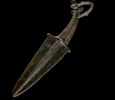Sino-Siberian Dagger
The nomadic nature of the Eurasian steppe tribes allowed for much integration and exchange of styles and customs, as well as physical transportable objects; including personal ornamentation and weaponry. Particularly between the Scythian tribes of the Black sea region in the West, Central Asian tribes such as the Hephthalites, the Wushu, Yuezhi and Mongolians to the East and the Persians further South. The blade of this piece has strong ties to daggers of the late Chinese Shang Dynasty, with a more stylised animal terminal, similar to the art of the Scythians. The stout blade is thick and double sided, suggesting durability for practical utilitarian purposes, however the handle is highly ornate compared to contemporaneous designs, possibly lending itself to the likelihood that it was owned by an important member of the tribe, or that it was for ceremonial/ burial rather than everyday use. The handle terminates in a highly ornate stylised elk or deer’s head, with hollow areas once presumably inlaid with stone. There is a small suspension loop under the chin of the animal, which shows this piece was work on a belt or strapping. Made from bronze, this piece would have been cast and then surface worked to create the finer details to the handle.
Antiquities, Sotheby’s, London, 21 April 1975, lot 239
David Aaron Ltd, 2021, No. 9.
Previously in the Private Collection of Colonel Norman Colville (1893–1974), Cornwall.
Sold at: Antiquities, Sotheby’s, London, 21 April 1975, lot 239.
Private Collection of Giancarlo Ligabue (1931–2015).
Private Collection, Switzerland.
Paris art market (accompanied by French cultural passport 164768).
ALR: S00106217.
Norman Colville (1893–1974) was educated at Fettes School, Edinburgh, and at Clare College, Cambridge University. He fought in the First World War, during which he was mentioned in despatches twice and awarded the Military Cross (M.C.). He retired from the military in 1919, with the rank of Captain, late of the Argyll and Sutherland Highlanders. In 1920, he purchased the Penheale Manor and Estate at Egloskerry. He occasionally deposited items at the British Museum for opinion (e.g. WAA, deposit-book entries dated 29 March, 5 April 1939, 2 September 1947).
Giancarlo Ligabue (1931–2015) graduated in Economics at the Ca’ Foscari University of Venice and in Geology at the Sorbonne, and later received five honorary degrees from the universities of Bologna, Venice, Modena, Lima and Ashgabat. Having participated in and directed over 130 expeditions around the world, he made several paleontological discoveries, such as the ‘Ligabueino’, a noasaurid dinosaur, named after him. He collaborated with Piero Angela to produce several science documentaries and became the president of the Natural History Museum of Venice, and later went on to create the ‘Ligabue Study and Research Centre’ in Venice.
Ligabue was also a businessman in the field of supplies and services for ships. He was the president of the basketball team Reyer Venezia Mestre between the early 1960s and early 1980s, and a member of the European Parliament for Forza Italia within the Forza Europa group between 1994 and 1999. His legacy and work is renowned around the world, and lives on today with the Ligabue Foundation. He was both an astute academic and passionate collector.










 Enquire
Enquire




